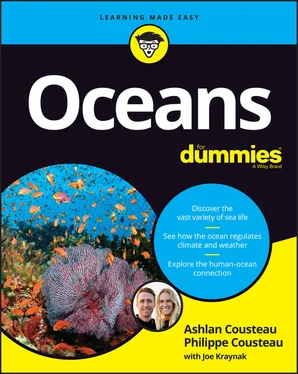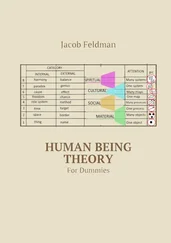All assumptions are foolish, and we’re always reluctant to make them, but to keep this book focused on the right audience and ensure that it delivers the information and insight you need to grasp a topic as broad as the ocean, we had to make the following foolish assumptions about you:
You’re curious about the ocean and eager to discover more about it.
You’re mostly interested in marine life, such as turtles, sharks, and dolphins and ecosystems, such as coral reefs and kelp forests.
You’re concerned about the health of the ocean, and you want to find out more about what can be done, what’s being done, and what you can do to help the ocean thrive.
Other than those three foolish assumptions, we can honestly say that we can’t assume much more about you. For all we know, you could be a precocious 4-year old or a spirited octogenarian, you may be a student, a white collar or blue collar worker, a housewife or househusband, a doctor, a lawyer, a plumber or a construction worker. You could be living on an island, a coast, deep in the Amazon jungle, or on a farm in the middle of Iowa. Regardless of your demographic, we applaud your interest in the ocean and your eagerness to expand your knowledge and understanding of Earth’s most precious blue gem.
Throughout this book, icons in the margins highlight certain types of valuable information that call out for your attention. Here are the icons you’ll encounter and a brief description of each.
 We want you to remember everything you read in this book, but if you can’t quite do that, then remember the important points flagged with this icon.
We want you to remember everything you read in this book, but if you can’t quite do that, then remember the important points flagged with this icon.
 The ocean is full of surprises both entertaining and mind blowing, and we don’t want you to miss any of them, so we use this Fun Fact icon to flag every single one.
The ocean is full of surprises both entertaining and mind blowing, and we don’t want you to miss any of them, so we use this Fun Fact icon to flag every single one.
 We don’t advise you to do anything very dangerous in this book so you won’t bump into many of these warning icons. In fact, we even try to alleviate any fears you may have about potentially dangerous marine creatures like big bad sharks (ooohhh), jellyfish, and sea snakes. Most of what you read in the news and see in the movies is way overblown. However, we did have a couple opportunities to use this icon, so watch out for it.
We don’t advise you to do anything very dangerous in this book so you won’t bump into many of these warning icons. In fact, we even try to alleviate any fears you may have about potentially dangerous marine creatures like big bad sharks (ooohhh), jellyfish, and sea snakes. Most of what you read in the news and see in the movies is way overblown. However, we did have a couple opportunities to use this icon, so watch out for it.
In addition to the ocean of information and insight we provide in this book, you have access to even more help and information online at Dummies.com , including a Cheat Sheet that serves as a quick reference guide to this book. We also posted a list of our ten favorite sea creatures — a bonus item that truly goes “beyond the book.” To access the Cheat Sheet, go to www.dummies.com and search for “Oceans For Dummies Cheat Sheet.”
You’re certainly welcome to read this book from cover to cover, but we wrote it in a way that facilitates skipping around. For a quick cruise around the ocean, turn to Chapter 1. To find out how the ocean formed and how marine life evolved (how the ocean as we know it came to be), head to Chapter 3. To scope out different areas of the ocean, head to Part 2, where we divide the ocean into zones and ecosystems and check out the seafloor.
All chapters in Part 3are required reading, but feel free to just flip through them at your leisure to look at all the pretty pictures. Words just can’t capture the beauty of the ocean and the creatures that call it home as well as photos can. Chapter 21is also required reading. One of the primary reasons we wrote this book is to recruit you to join our mission to save the ocean — one of the world’s most precious resources. In Chapter 24, we provide a menu of easy ways you can help.
Other than that, you’re pretty much on your own to explore at your own pace and as your curiosity leads you. Enjoy!
Part 1
Getting Started with Your Ocean Voyage
IN THIS PART …
Take a quick primer on ocean fundamentals — from dividing the ocean into oceans (plural) and getting up to speed on the water cycle to engaging in a quick meet-and-greet with the ocean’s inhabitants.
Take inventory of the various ways the ocean contributes to our health and happiness, not to mention our very existence.
Discover how the ocean and oceans formed and how life on Earth may have begun.
Trace the evolution of marine life from the Paleozoic to the Cenozoic era and everything in between.
Look ahead to find out what the future of the ocean might look like.
Chapter 1
Brushing Up on Ocean Fundamentals
IN THIS CHAPTER
 Getting a big-picture view of the ocean and related bodies of water
Getting a big-picture view of the ocean and related bodies of water
 Wrapping your brain around the water cycle
Wrapping your brain around the water cycle
 Sampling the vast diversity of ocean life
Sampling the vast diversity of ocean life
 Building a mutually beneficial relationship with the ocean
Building a mutually beneficial relationship with the ocean
Before you dive into any large or complex topic, you’re wise to step back and look at the big picture. A general understanding provides a framework on which to hang the details. In this chapter, we provide that framework, establishing a context for understanding the many facets of the ocean and how they all fit together.
We start by introducing you to the ocean and breaking it down into its five “oceans.” Then, we get into a few topics in the realm of physical oceanography — the water cycle, the shapes of the ocean basins, meteorology, and other properties and processes that explain what makes the ocean tick from a physical standpoint. We then introduce you to the various groups of life-forms that populate the ocean — plants, animals, and beings that fit in neither (or both) categories. Finally, we wrap things up with a discussion of the ocean’s current state and the human-ocean relationship — the benefits we gain from the ocean and our responsibilities as environmental stewards in protecting and preserving it.
Get ready for a wild ride. In this chapter, we cover a lot of ground, not to mention all that water!
Taking a Nickel Tour of the Ocean(s)
The ocean is big. How big? Well, it covers about 360 million square kilometers (140 million square miles), which is just a smidgen more than 70 percent of Earth’s surface. Volume-wise it contains approximately 1.3 billion cubic kilometers (321 million cubic miles) of water — that translates to about 352 quintillion gallons, which accounts for about 97 percent of Earth’s water. In terms of living space, the ocean comprises about 99 percent of the biosphere — all land, water, and atmosphere where life on Earth exists.
Because it’s so big, people have developed all sorts of ways to slice and dice it to better understand and describe the different areas that make it up.
Читать дальше

 We want you to remember everything you read in this book, but if you can’t quite do that, then remember the important points flagged with this icon.
We want you to remember everything you read in this book, but if you can’t quite do that, then remember the important points flagged with this icon. The ocean is full of surprises both entertaining and mind blowing, and we don’t want you to miss any of them, so we use this Fun Fact icon to flag every single one.
The ocean is full of surprises both entertaining and mind blowing, and we don’t want you to miss any of them, so we use this Fun Fact icon to flag every single one. We don’t advise you to do anything very dangerous in this book so you won’t bump into many of these warning icons. In fact, we even try to alleviate any fears you may have about potentially dangerous marine creatures like big bad sharks (ooohhh), jellyfish, and sea snakes. Most of what you read in the news and see in the movies is way overblown. However, we did have a couple opportunities to use this icon, so watch out for it.
We don’t advise you to do anything very dangerous in this book so you won’t bump into many of these warning icons. In fact, we even try to alleviate any fears you may have about potentially dangerous marine creatures like big bad sharks (ooohhh), jellyfish, and sea snakes. Most of what you read in the news and see in the movies is way overblown. However, we did have a couple opportunities to use this icon, so watch out for it. Getting a big-picture view of the ocean and related bodies of water
Getting a big-picture view of the ocean and related bodies of water










